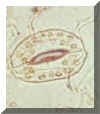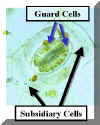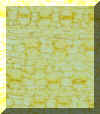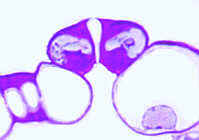 |
Surface view of Agave epidermis. Note the shape of the typical cells. Locate the Stomata. The Stomatal Apparatus is composed of Guard Cells and the Stoma or opening. Subsidiary Cells may also be present. | ||
 |
Lily (Lilium) epidermis with elongated epidermal cells plus Stomata. I use Stomata or Stomatal Apparatus to indicate the compliment of cells and the opening. Some authors use a slightly different nomenclature. | ||
 |
Fuchsia epidermis with highly undulating cell walls and Guard Cells. Note the Chloroplasts in the Guard Cells. Epidermal cells have poorly differentiated plastids. However, the Guard Cells have chloroplasts which are important for stomatal functions. | ||
 |
Higher magnification of Guard Cells from Fuchsia epidermis. Note the Chloroplasts. | ||
 |
The Subsidiary Cells play an active role in the opening and closing of the Guard Cells. | ||
 |
Epidermis of Coconut Palm - Note the diversity of cell types! Epidermal wall patterns can be very complex and can be used to identify plants. | ||
 Stomata from Bryophyllum - Locate the Guard Cells & the Subsidiary Cells |
|||
 |
Stomata of Peony Locate the Guard Cells & the Subsidiary Cells, if present. | ||
 |
The Guard Cells often have projections from the outer tangential walls which border the Stoma. Locate these in this picture! Locate the Plastids and the Subsidiary Cells without looking at the pictures below! |
||
 |
 Stomata of Hawaiian Silversword |
||
 |
Anthocyanins are often found in the vacuoles of Epidermal cells. What are the potential functions of these? The vacuoles in Guard Cells also play an important role in stomatal functions. |
||
| Lecture Directory | Prior Page |
 Home Page |
Next Page |
|---|---|---|---|